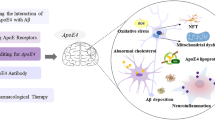Summary
α1-Antichymotrypsin (ACT), a component of the senile plaque of the Alzheimer's disese (AD) brain, has a possible role as a molecular chaper-one in developing AD pathology. This study was a search for the possible association of the two structural polymorphisms of ACT, Ala15 → Thr and Met389 → Val in the Japanese population. In 101 AD patients, genotype and allele frequencies of the two polymorphisms did not differ from those of 104 age-matched healthy controls. However, in those subjects in which the apolipoprotein ɛ4 allele was absent, the frequency of the Ala15 homozygote was significantly higher in the AD patients than in controls. This suggests that the Ala15 homozygote state may be a susceptibility marker for AD, interacting with apolipoprotein E genotype.
Similar content being viewed by others
References
Abraham CR, Selkoe DJ, Potter H (1988) Immunochemical identification of the serine protease inhibitor α1-antichymotrypsin in the brain amyloid deposits of Alzheimer's disease. Cell 52: 487–501
Corder EH, Saunders AM, Strittmatter WJ, Schmechel PC, Gaskell PC, Small GW, Roses AD, Haines JL, Pericak-Vance MA (1993) Gene dose of apolipoprotein E type 4 allele and the risk of Alzheimer's disease in late onset families. Science 261: 921–923
Kamboh MI, Sanghera DK, Ferrell RE, DeKosky ST (1995) APOE*4-associated Alzheimer's disease risk is modified by α1-antichymotrypsin polymorphism. Nature Genet 10: 486–488
Ma J, Yee A, Brewer Jr. HB, Das S, Potter H (1994) Amyloid-associated proteins α1-antichymotrypsin and apolipoprotein E promote assembly of Alzheimer β-protein into filaments. Nature 372: 92–94
Matsubara E, Hirai S, Amari M, Shoji M, Yamaguchi H, Okamoto K, Ishiguro K, Harigaya Y, Wakabayashi, K (1990) α1-antichymotrypsin as a possible biochemical marker for Alzheimer-type dementia. Ann Neurol 28: 561–567
Mayeux R, Stern Y, Ottman R, Tatemichi TK, Tang M-X, Maestre G, Ngai C, Tycko B, Ginsberg H (1993) The apolipoprotein ɛ4 allele in patients with Alzheimer's disease. Ann Neurol 34: 752–754
McKhann G, Drachman D, Folstein M, Katzman R, Price D, Stadlan EM (1984) Clinical diagnosis of Alzheimer's disease: report of the NINCDS-ADRDA Work Group under the auspices of Department of Health and Human Services Task Force on Alzheimer's disease. Neurology 34: 939–944
Probst A, Brunnschweiler H, Lautenschlager C, Ulrich J (1987) A special type of senile plaque, possibly an initial stage. Acta Neuropathol 74: 133–141
Randall LL, Hardy SJS (1989) Unity in function in the absence of consensus in sequence: role of leader peptides in export. Science 243: 1156–1159
Rozemuller JM, Abbink JJ, Kamp AM, Stam FC, Hack CE, Eikelenboom P (1991) Distribution pattern and functional state of α1-antichymotrypsin in plaques and vascular amyloid in Alzheimer's disease. Acta Neuropathol 82: 200–207
Sanan DA, Weisgraber KH, Russell SJ, Mahley RW, Huang D, Saunders A, Schmechel D, Wisniewski T, Frangione B, Roses AD, Strittmatter WJ (1994) Apolipoprotein E associates with β amyloid peptide of Alzheimer's disease to form novel monofibrils. J Clin Invest 94: 860–869
Selkoe DJ (1991) The molecular pathology of Alzheimer's disease. Neuron 6: 487–498
Strittmatter WJ, Saunders AM, Schmechel D, Pericak-Vance M, Enghild J, Salvesen GS, Roses AD (1993) Apolipoprotein E: high avididy binding to β-amyloid and increased frequency of type 4 allele in late onset familial Alzheimer disease. Proc Natl Acad Sci USA 90: 1977–1981
Talbot C, Houlden H, Craddock N, Crook R, Hutton M, Lendon C, Prihar G, Morris JC, Hardy J, Goate A (1996) Polymorphism in AACT gene may lower age of onset of Alzheimer's disease. NeuroReport 7: 534–536
Thome J, Baumer A, Kornhuber J, Rosier M, Riederer P (1995) Alpha-1-antichymotrypsin bi-allele polymorphism, apolipoprotein-E tri-allele polymorphism and genetic risk of Alzheimer's syndrome. J Neural Transm [P-D Sect] 10: 207–212
Tsuda M, Sei Y, Yamamura M, Yamamoto M, Shinohara Y (1992) Detection of a new mutant α-1-antychymotrypsin in patients with occlusive-cerebrovascular disease. FEBS Lett 304: 66–68
Wenham PR, Price WH, Blundell G (1991) Apolipoprotein E genotyping by one-stage PCR. Lancet 337: 1158–1159
Wisniewski T, Frangione B (1992) Apolipoprotein E: a pathological chaperone protein in patients with cerebral and systemic amyloid. Neurosci Lett 135: 235–238
Wisniewski T, Castano EM, Golabek A, Vogel T, Frangione B (1994) Acceleration of Alzheimer's fibril formation by apolipoprotein E in vitro. Am J Pathol 145: 1030–1035
Author information
Authors and Affiliations
Rights and permissions
About this article
Cite this article
Muramatsu, T., Matsushita, S., Arai, H. et al. α1-Antichymotrypsin gene polymorphism and risk for Alzheimer's disease. J. Neural Transmission 103, 1205–1210 (1996). https://doi.org/10.1007/BF01271205
Received:
Accepted:
Issue Date:
DOI: https://doi.org/10.1007/BF01271205




